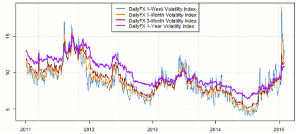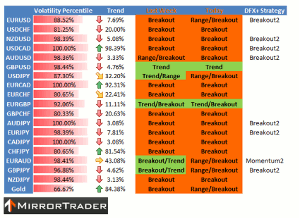David Rodriguez, of DailyFX.com, shares a video in which he highlights the current forex volatility spike and why he feels that—for the US dollar versus the euro—though volatility prices remain elevated ahead of another key week, elevated reversal risk is still real.
- US Dollar positioning is stretched, reversal risk seems especially high this week
- One-sided retail FX trader sentiment keeps our eye on euro, yen, and Commodity Bloc
- We will stick to the volatility-friendly Breakout2 trading system across major pairs
Key economic event risk in the week ahead promises major FX moves and volatility prices continue to trade near multi-year peaks. Overall momentum clearly favors further US dollar gains; the trend is up until it isn't. Yet, it is increasingly difficult to ignore one-sided professional trader positions as recent CFTC Commitment of Traders data shows EUR/USD positions at 3-year extremes.
Forex Volatility Prices Remain Elevated Ahead of Another Key Week

Data source: Bloomberg, DailyFX Calculations
Click to Enlarge
Our trading strategy is thus somewhat contingent on the dollar's next steps, but overall we feel that the volatility-friendly Breakout2 trading system may do well given elevated FX vols. Past performance is not indicative of future results, but the strategy has done well in Commodity Bloc pairs (AUD/USD, NZD/USD, USD/CAD). It could continue to outperform if we see further moves from key US dollar counterparts.
It, nonetheless, remains critical to note that volatility can work for and against us. It will be critical to keep trading leverage low in what promises to be another big week for FX markets.
DailyFX Individual Currency Pair Conditions and Trading Strategy Bias
Definitions
Volatility Percentile-The higher the number, the more likely we are to see strong movements in price. This number tells us where current implied volatility levels stand in relation to the past 90-days of trading. We have found that implied volatilities tend to remain very high or very low for extended periods of time. As such, it is helpful to know where the current implied volatility level stands in relation to its medium-term range.
Trend-This indicator measures trend intensity by telling us where price stands in relation to its 90-trading day range. A very low number tells us that price is currently at or near 90-day lows, while a higher number tells us that we are near the highs. A value at or near 50% tells us that we are at the middle of the currency pair's 90-day range.
Range High-90-day closing high.
Range Low-90-day closing low.
Last-Current market price.
Bias-Based on the above criteria, we assign the more likely profitable strategy for any given currency pair. A highly volatile currency pair (volatility percentile very high) suggests that we should look to use breakout strategies. More moderate volatility levels and strong trend values make momentum trades more attractive, while the lowest volume percentile and trend indicator figures make range trading the more attractive strategy.
By David Rodriguez, Quantitative Strategist, DailyFX.com






















